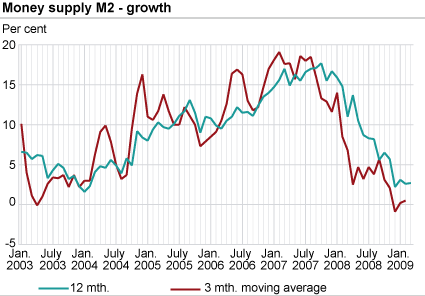Content
Published:
This is an archived release.
Low growth in money supply
The twelve-month growth in total money supply was 2.7 per cent to end-March, up from 2.6 per cent to end-February. Most of the increase in the M2 growth came from non-financial enterprises.
The money supply amounted to NOK 1 491 billion at end-March, down from NOK 1 500 billion at end-February. The money supply fell for the second month in a row.
Rise in growth for non-financial enterprise money supply
Non-financial enterprise money supply amounted to NOK 512 billion at end-March, up from NOK 500 billion at end-February. The twelve-month growth was -0.6 per cent, up from -3.1 per cent in the previous month. This growth rate was negative for fifth month in a row, from higher than 20 per cent as recently as December 2007. Non-financial enterprise money supply constituted 42 per cent of their gross domestic debt measured by the credit indicator C2 at end-March.
Other financial enterprise and household money supply pulls down the growth
The twelve-month growth for other financial enterprise money supply (other than state lending institutions, banks and money market funds) was -6.7 per cent to end-March, down from 1.2 per cent to end-February. This growth has not been lower since December 2006. Other financial enterprise money supply amounted to NOK 135 billion at end-March.
At end-March, more than half (NOK 792 billion) of the broad monetary aggregate was owned by households. The twelve-month growth in household money supply decreased from 7.0 per cent to 6.6 per cent during March. The growth in household money supply was slightly lower than the growth in household gross domestic debt, which was 6.7 per cent to end-March, as shown by the credit indicator C2 . For more information on the financial position of households, see the financial accounts in the national accounts .
| October 2008 | November 2008 | December 2008 | January 2009 | February 2009 | March 2009 | ||||||||||||||||||||||||||||||||||
|---|---|---|---|---|---|---|---|---|---|---|---|---|---|---|---|---|---|---|---|---|---|---|---|---|---|---|---|---|---|---|---|---|---|---|---|---|---|---|---|
| M0 - 12 mth. | 59.8 | 115.8 | 43.0 | 103.4 | 147.1 | 39.1 | |||||||||||||||||||||||||||||||||
| M1 - 12 mth. | -3.9 | -4.2 | -5.2 | -4.5 | -3.9 | -3.9 | |||||||||||||||||||||||||||||||||
| M2 - 12 mth. | 6.5 | 5.7 | 2.2 | 3.1 | 2.6 | 2.7 | |||||||||||||||||||||||||||||||||
| M2 - 3 mth. moving average | 3.1 | 2.1 | -0.9 | 0.2 | 0.5 | ||||||||||||||||||||||||||||||||||
| M2 households - 12 mth. | 7.3 | 7.1 | 8.0 | 7.4 | 7.0 | 6.6 | |||||||||||||||||||||||||||||||||
| M2 non-financial enterprises - 12 mth. | 0.1 | -1.3 | -5.1 | -1.2 | -3.1 | -0.6 | |||||||||||||||||||||||||||||||||
Strong decline in base money
Base money (see below) amounted to NOK 118 billion at end-March. The twelve-month growth in M0 was 39.1 per cent, down from 147.1 per cent to end-February. This decrease is connected to reduced bank deposits in Norges Bank of more than NOK 40 billion.
|
The money supply (broad monetary aggregate) M2 consists of notes and coins, unrestricted bank deposits, certificates of deposit and units in money market funds owned by the money-holding sector i.e. households, non-financial enterprises, municipalities and financial enterprises other than state lending institutions, banks and money market funds. |
|
The base money (M0) is defined as banks and the money-holding sector's (see above) notes and coins and deposits with Norges Bank. Banks’ deposits with Norges Bank comprise current account (sight) deposits and fixed rate (time) deposits (F-deposits), from Norges Bank’s monthly balance sheet. |
The statistics is published with Monetary aggregates.
Contact
-
Statistics Norway's Information Centre
E-mail: informasjon@ssb.no
tel.: (+47) 21 09 46 42

